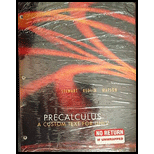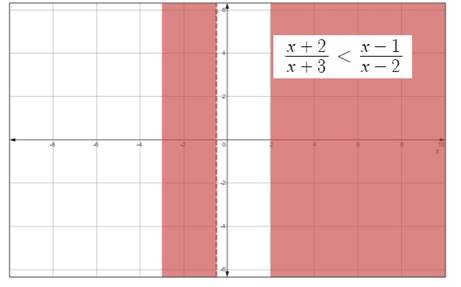
To solve: the nonlinear inequality. Express the solution using interval notation and graph the solution set.
Answer to Problem 69E
Explanation of Solution
Given:
The given inequality is
Concept used:
Guidelines for solving nonlinear inequality:
- Move all terms to one side.
- Factor the non-zero side of the inequality.
- Find the value for which each factor is zero. The number will divide the real lines into interval. List the interval determined by these numbers.
- Make a table or diagram by using test values of the signs of each factor on each interval. In the last row of the table determining the sign of the product of these factors.
- Determine the solution of the inequality from the last row of the sign table.
Calculation:
The given inequality can be expressed as
Multiply both sides by
Firstto find the zeros of the expression in the numerator and demniminator, then
From the three zeros above, it extracts the following intervals:
Now, make a table by using test values of the signs of each factor on each interval.
| + | + | |||
| + | + | + | ||
| + | ||||
| quotient | + | + |
As it is seen that the grater than or equal to 0 in the interval
Hence,the solution set is
The solution set of the inequality graphed on the number line.

The graph of the non-linear inequality

Chapter 1 Solutions
Precalculus - A Custom Text for UNLV
- Explain the key points and reasons for the establishment of 12.3.2(integral Test)arrow_forwardUse 12.4.2 to determine whether the infinite series on the right side of equation 12.6.5, 12.6.6 and 12.6.7 converges for every real number x.arrow_forwarduse Cauchy Mean-Value Theorem to derive Corollary 12.6.2, and then derive 12.6.3arrow_forward
- Explain the focus and reasons for establishment of 12.5.1(lim(n->infinite) and sigma of k=0 to n)arrow_forwardExplain the focus and reasons for establishment of 12.5.3 about alternating series. and explain the reason why (sigma k=1 to infinite)(-1)k+1/k = 1/1 - 1/2 + 1/3 - 1/4 + .... converges.arrow_forwardExplain the key points and reasons for the establishment of 12.3.2(integral Test)arrow_forward
 Calculus: Early TranscendentalsCalculusISBN:9781285741550Author:James StewartPublisher:Cengage Learning
Calculus: Early TranscendentalsCalculusISBN:9781285741550Author:James StewartPublisher:Cengage Learning Thomas' Calculus (14th Edition)CalculusISBN:9780134438986Author:Joel R. Hass, Christopher E. Heil, Maurice D. WeirPublisher:PEARSON
Thomas' Calculus (14th Edition)CalculusISBN:9780134438986Author:Joel R. Hass, Christopher E. Heil, Maurice D. WeirPublisher:PEARSON Calculus: Early Transcendentals (3rd Edition)CalculusISBN:9780134763644Author:William L. Briggs, Lyle Cochran, Bernard Gillett, Eric SchulzPublisher:PEARSON
Calculus: Early Transcendentals (3rd Edition)CalculusISBN:9780134763644Author:William L. Briggs, Lyle Cochran, Bernard Gillett, Eric SchulzPublisher:PEARSON Calculus: Early TranscendentalsCalculusISBN:9781319050740Author:Jon Rogawski, Colin Adams, Robert FranzosaPublisher:W. H. Freeman
Calculus: Early TranscendentalsCalculusISBN:9781319050740Author:Jon Rogawski, Colin Adams, Robert FranzosaPublisher:W. H. Freeman
 Calculus: Early Transcendental FunctionsCalculusISBN:9781337552516Author:Ron Larson, Bruce H. EdwardsPublisher:Cengage Learning
Calculus: Early Transcendental FunctionsCalculusISBN:9781337552516Author:Ron Larson, Bruce H. EdwardsPublisher:Cengage Learning





